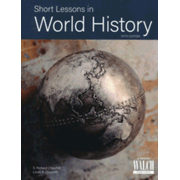At only 194 pages, this is definitely a shorter text for World History than most. The text portions are actually even briefer than you might be thinking since this is also a worktext with questions, map work, and activities such as crossword puzzles built into the lessons.
Despite its brevity, this book should be used with children in grades six and up. The publisher suggests grades six through nine, but you might use it with older students who need to cover the broad swaths of history and have little time to accomplish it. Short Lessons was written as a supplement to a standard World History text so be cautious about awarding credit for a high school course if this is the only resource used by the student. (Note: I have trouble envisioning this as a supplement to a text since it repeats and summarizes information students would already encounter in the text.)
Short Lessons in World History might also be used as a spine for a real books approach to history. The book is divided into 14 units. Each unit begins with a list of timeline dates and events, a handy feature for those creating timelines. Following the timeline lists is a set of three or four questions titled "Activating Prior Knowledge." These questions alert students to key themes or information to which they should pay attention, while also prompting some critical thinking. You might come back to these at the end of the unit and use them as "wrap-up" questions.
The text information is necessarily brief, although it does a fairly good job of hitting the highlights of world history. Western Civilization gets the most attention, although the first unit covering early civilizations necessarily deals with the Mid East, Africa, and Asia. Also, the third unit covering "Empires and Civilizations Around the World" addresses India, China, Japan, Africa, and the Americas, albeit very briefly. Coverage of history includes events up to 2005. However, the brevity sometimes leaves students with inadequate understanding of certain events. For example, the French Revolution is covered in only three paragraphs, leaving the reader with a generally positive impression of its results (p. 64). But this is not necessarily a problem if you use the "Critical Thinking" questions that appear in highlighted boxes throughout each unit. After the discussion of the American, French, and South American revolutions (about one full page of information), the critical thinking question reads, "The people of North and South America fought in revolutions. So did the people of France. What problems would people face after they overthrew their rulers?"(p. 65). If students pursue further reading and thinking to answer this question, they will likely develop a decent understanding of the French Revolution.
Sets of review questions also appear frequently throughout each unit. Some of these sets are linked to maps, with answers determined through analysis of the map. Puzzes such as crosswords, unscrambling lettters, and word searches are also used as review tools.
Brief biographies of key figures, events or other pertinent information often appears in boxes. Vocabulary words and their definitions (many of which should already be familiar to students) are shown in the right hand column of each page, parallel to their appearance in the text. Those same words are also found in a glossary at the back of the book. This sort of assistance, along with the fact that the reading level seems fairly easy, makes Short Lessons a good choice for students with learning difficulties. Even so, the critical thinking questions provide an appropriate challenge for students in grades 6-9 (and possibly beyond that), so the book is not limited to remedial or LD situations.
The teacher's guide serves as your answer key, and it also includes reproducible lessons on using maps to study World History.
The perspective of the book is secular. However, it begins with the Sumerian civilization rather than with an evolutionary treatment. The treatment of Christianity is fair.












